
| Home | Deepsky Atlas | TheAstronews | Links | Solar System | ||||||

Hawaiian Astronomical SocietyConstellations: Scorpius -- The Scorpion who Killed Orion |
||||||||||
In Greek mythology, the story of Scorpius involves Orion, the hunter. Orion boasted that he was the greatest hunter in the universe. When Zeus' wife, Hera, heard what he was saying, she became infuriated and sent a poisonous scorpion to kill him. Orion fought with this creature for days and nights without any success. When weary Orion was not looking, the creature sneaked in and stung him to death. Zeus took pity on Orion and placed him in the heavens where he appears as a giant, with a girdle, sword, lion's skin, and club. Hera placed the scorpion in the heavens at the opposite end of the sky, so even now, Orion tries to avoid the creature by hiding until it is completely under the horizon. On the other hand Scorpius rises in the east when a few stars of Orion still linger above the western horizon.
In Hawaii, we know Scorpius as the demigod Maui's Fishhook. One day Maui went fishing with his brothers in their outrigger canoe. He brought with him a magic fishhook, instructing his brothers that whatever he caught with it, they were to continue paddling and never look back. Maui caught a huge object and asked his brothers to paddle harder while he pulled the line. As Maui hauled, many rocks appeared. The more he pulled, the more rocks appeared. Finally, he pulled hard enough that the large chunks of land surfaced from the ocean. His brothers, tired from all the rowing, and curious about Maui's catch, looked back. One of the brothers called out, "Look, Maui is pulling up land!" Furious, Maui responded, "Fools! Had you not looked back, these islands would have been a great land." We now know these islands as Hawaii. New Zealanders tell a similar story about Maui and their land.
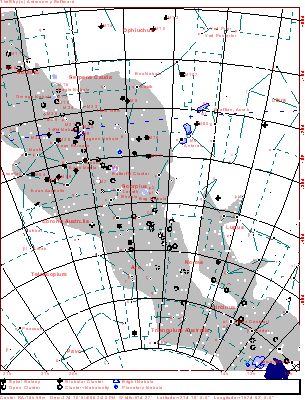
Click the map for a 916x1200 version of the above. Click here for a map better suited for use in the field.
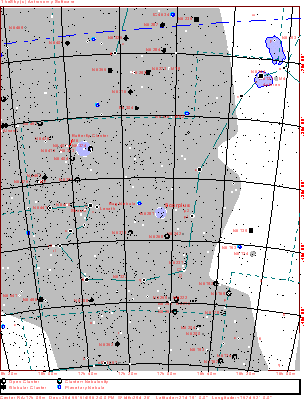
This a more detailed view of the constellation. The map displays stars to magnitude 10, and deepsky objects to magnitude 12. Click here for a map better suited for use in the field.
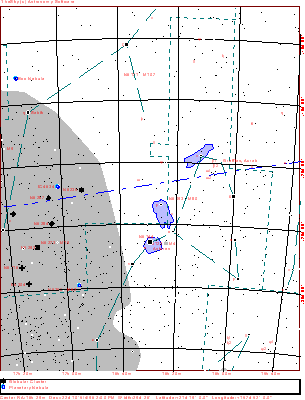
Click here for a map better suited for use in the field.
 84k JPEG. M7 (NGC6475) This open cluster is sometimes called Ptolemy's cluster because the first description we have of the open cluster is from the second century C.E. (formerly A.D.) Claudius Ptolemaeus, who described it as a fuzzy patch following the scorpion's stinger. The fuzzy patch resolves into stars in binoculars. Dreyer calls it very bright (mag. 3.3), pretty rich with stars of roughly 7-12 mag. It covers about 1.3° of the sky. The mag. 10, 3.5' wide globular cluster NGC6453 sits on M7's western border. It brightens toward the middle but does not resolve into stars. 84k JPEG. M7 (NGC6475) This open cluster is sometimes called Ptolemy's cluster because the first description we have of the open cluster is from the second century C.E. (formerly A.D.) Claudius Ptolemaeus, who described it as a fuzzy patch following the scorpion's stinger. The fuzzy patch resolves into stars in binoculars. Dreyer calls it very bright (mag. 3.3), pretty rich with stars of roughly 7-12 mag. It covers about 1.3° of the sky. The mag. 10, 3.5' wide globular cluster NGC6453 sits on M7's western border. It brightens toward the middle but does not resolve into stars.
Ptolemy summarized the ancient knowledge of astronomy. What is less known is that he did the same for geography and music. He was quite a man, even if many of his ideas haven't held up.
|
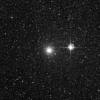 19k JPEG. NGC6441 is a globular cluster located 2.3° SSW of M7, just off the stinger of the scorpion. A bright (mag. 3.2) star (SAO 209318) sits just to the west. Dreyer describes it as very bright (mag. 7.2), pretty large 7.8'), round, very gradually much brighter middle, resolvable, with stars of magnitude 18 (other sources give mag. 15.4). A 13" will make the outer regions grainy. This image is from the Digital Sky Survey. 19k JPEG. NGC6441 is a globular cluster located 2.3° SSW of M7, just off the stinger of the scorpion. A bright (mag. 3.2) star (SAO 209318) sits just to the west. Dreyer describes it as very bright (mag. 7.2), pretty large 7.8'), round, very gradually much brighter middle, resolvable, with stars of magnitude 18 (other sources give mag. 15.4). A 13" will make the outer regions grainy. This image is from the Digital Sky Survey.
|
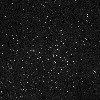 94k JPEG. M6 (NGC6405) is located 5° NNE of Shaula, the stinger of the scorpion. A bright (mag. 4.2) cluster, Dreyer describes it as large (15'), irregular, loose, with stars of mag. 7-10. This image is from the Digital Sky Survey. 94k JPEG. M6 (NGC6405) is located 5° NNE of Shaula, the stinger of the scorpion. A bright (mag. 4.2) cluster, Dreyer describes it as large (15'), irregular, loose, with stars of mag. 7-10. This image is from the Digital Sky Survey.
|
 19k JPEG. NGC6388 (Bennett 96) is a globular cluster located 1.7° south of Theta Scorpii. Dreyer's description reads very bright (mag. 6.8), large (8.7'), round, fairly gradually, then fairly abruptly very much brighter middle, well resolved, stars of magnitude 17 and fainter. Others claim the cluster's brightest stars are mag. 14.8. A good object for a large instrument. Smaller telescopes will enjoy the rich field. Image from the Digital Sky Survey. 19k JPEG. NGC6388 (Bennett 96) is a globular cluster located 1.7° south of Theta Scorpii. Dreyer's description reads very bright (mag. 6.8), large (8.7'), round, fairly gradually, then fairly abruptly very much brighter middle, well resolved, stars of magnitude 17 and fainter. Others claim the cluster's brightest stars are mag. 14.8. A good object for a large instrument. Smaller telescopes will enjoy the rich field. Image from the Digital Sky Survey.
|
 57k JPEG. NGC6318 (Bennett 91a) is a mag. 11.8 open cluster described as fairly large (4'), rich in stars, round, gradually brighter middle, and containing stars of magnitude 12 to 14. This cluster begins to resolve in a 6", but a 10" doubles the cluster's size from the diameter listed, and reveals a little north-south elongation. 57k JPEG. NGC6318 (Bennett 91a) is a mag. 11.8 open cluster described as fairly large (4'), rich in stars, round, gradually brighter middle, and containing stars of magnitude 12 to 14. This cluster begins to resolve in a 6", but a 10" doubles the cluster's size from the diameter listed, and reveals a little north-south elongation.
Image from the Digital Sky Survey. Note the lack of a cluster at the coordinates given. This appears to be an error in the NGC Catalog. Both Uranometria 2000 (see the image) and the NGC/IC Project offer corrected positions.
|
 12k JPEG. NGC6302 (Caldwell 69) is the Bug Nebula. Located 4° west of Shaula (Gamma Scorpii), Dreyer calls this planetary pretty bright (mag. 13), elongated (2'x1') east-west. Don't let the dim magnitude fool you. There is a three magnitude difference here between visual magnitude, and the photographic magnitudes given here. Photograph from the Astronomical Images Archive. 12k JPEG. NGC6302 (Caldwell 69) is the Bug Nebula. Located 4° west of Shaula (Gamma Scorpii), Dreyer calls this planetary pretty bright (mag. 13), elongated (2'x1') east-west. Don't let the dim magnitude fool you. There is a three magnitude difference here between visual magnitude, and the photographic magnitudes given here. Photograph from the Astronomical Images Archive.
|
 34k JPEG. NGC6242 is an open cluster located 1.6° SSE of Mu Scorpii in the scorpion's "tail." Dreyer describes it as bright (mag. 6.4, large (9') and rich, with about 23 stars from mags. 8-11. Photograph from the Digital Sky Survey. 34k JPEG. NGC6242 is an open cluster located 1.6° SSE of Mu Scorpii in the scorpion's "tail." Dreyer describes it as bright (mag. 6.4, large (9') and rich, with about 23 stars from mags. 8-11. Photograph from the Digital Sky Survey.
|
 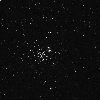 5k GIF & 38k JPEG. Caldwell 76 (NGC6231) is an open cluster located .6° NNW of Zeta Scorpii. Dreyer describes it as bright (mag. 2.6), quite large (15'), fairly rich with stars mostly from mags. 10-13, but the brightest ones slightly more than mag. 5. The first image is a drawing by "Larry" from observations through an 8" Dobsonian. The second is an image from the Digital Sky Survey. 5k GIF & 38k JPEG. Caldwell 76 (NGC6231) is an open cluster located .6° NNW of Zeta Scorpii. Dreyer describes it as bright (mag. 2.6), quite large (15'), fairly rich with stars mostly from mags. 10-13, but the brightest ones slightly more than mag. 5. The first image is a drawing by "Larry" from observations through an 8" Dobsonian. The second is an image from the Digital Sky Survey.
|
 61k JPEG. NGC6216 (Bennett 81) is a mag. 10 open cluster located 2.4° SSW of Zeta Scorpii off the bend in the "stinger's" tail. The Dreyer description reads: Fairly small (4'), fairly rich (40 stars), fairly compressed, with stars of mag. 12-15. Image from the Digital Sky Survey. 61k JPEG. NGC6216 (Bennett 81) is a mag. 10 open cluster located 2.4° SSW of Zeta Scorpii off the bend in the "stinger's" tail. The Dreyer description reads: Fairly small (4'), fairly rich (40 stars), fairly compressed, with stars of mag. 12-15. Image from the Digital Sky Survey.
|
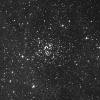 56k JPEG. NGC6192 (Bennett 79b) is a mag. 9 open cluster located 2.8 degrees WSW of Zeta Scorpii in the bend of the "stinger." Dreyer says it is fairly large (8'), fairly rich (about 60 stars), and somewhat irregular in shape. It contains stars of mags. 11-14. Some observers see dark lanes with larger instruments. Image from the Digital Sky Survey. 56k JPEG. NGC6192 (Bennett 79b) is a mag. 9 open cluster located 2.8 degrees WSW of Zeta Scorpii in the bend of the "stinger." Dreyer says it is fairly large (8'), fairly rich (about 60 stars), and somewhat irregular in shape. It contains stars of mags. 11-14. Some observers see dark lanes with larger instruments. Image from the Digital Sky Survey.
|
 11k JPEG. NGC6153 is a small (25"), almost stellar, dim (mag. 12) planetary nebula 1.2° ENE of NGC6124. From the Digital Sky Survey. 11k JPEG. NGC6153 is a small (25"), almost stellar, dim (mag. 12) planetary nebula 1.2° ENE of NGC6124. From the Digital Sky Survey.
|
NGC6139 (Bennett 78) is a globular cluster that lies 52' north of NGC6124. Dreyer says it is bright (mag. 9.2), fairly large (5.5'), round, with a fairly abruptly brighter middle. A 12" to 13" will just begin to resolve this one into stars.
Image is a mosaic from the Digital Sky Survey.
|
Roughly 1° ENE of M4, and 37' north-west of Antares, lies NGC6144 (Bennett 77), another globular cluster. It's described as quite large, much condensed, brightening gradually toward the middle, and "extremely resolvable." To translate that last statement: A 17" to 20" will begin to resolve a few of the stars.
The image on the left, containing both clusters, is from the Digital Sky Survey. It has been processed to bring out the nebulosity engulfing NGC6144. The nebulosity actually centers on Antares. The image on the right is a mosaic released by the Hubble Space Telescope team.
|
 88k JPEG. M80 (NGC6093) is located 4.5° NW of Antares (Alpha Scorpii). A poor cousin to M4, it is quite different, being far more condensed. It shines at mag. 7.2 and extends 9'. This image is from the Digital Sky Survey. M80 sits in the lower left of this photo. IC4596 (mag. 15.5) is the edge on spiral galaxy in the upper right. Other galaxies lie in between, the brightest of which is IC4600, a less well defined galaxy. 88k JPEG. M80 (NGC6093) is located 4.5° NW of Antares (Alpha Scorpii). A poor cousin to M4, it is quite different, being far more condensed. It shines at mag. 7.2 and extends 9'. This image is from the Digital Sky Survey. M80 sits in the lower left of this photo. IC4596 (mag. 15.5) is the edge on spiral galaxy in the upper right. Other galaxies lie in between, the brightest of which is IC4600, a less well defined galaxy.
|
If you have any questions about the Hawaiian Astronomical Society
please
(link requires javascript).